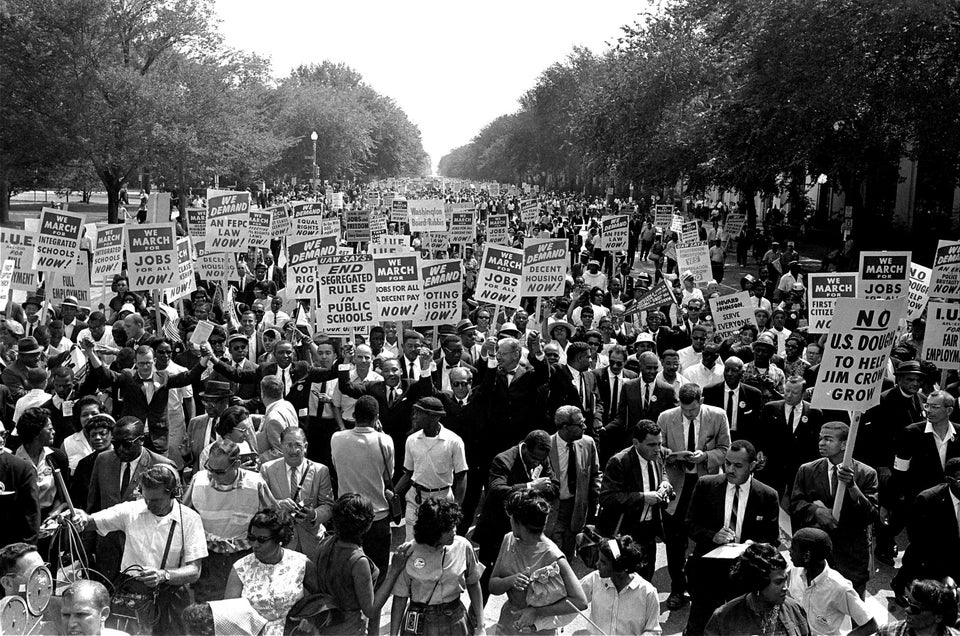
For the Rev. Dr. Otis Moss III, the civil rights movement is not a period of time that only exists in history books; the movement runs deep in his veins -- literally.
With a mother who was a secretary for the Southern Christian Leadership Conference, and a father who was an early organizer for the movement, an active minister and regional director for the SCLC, both of whom were eventually married to each other by the Rev. Martin Luther King Jr. himself, Moss has deeply rooted ties to the history of social activism.
As close family friends of not only the Kings, but also other noteworthy individuals like Fannie Lou Hamer, Ralph David Abernathy and Andrew Young, Moss’ parents created an environment where spirituality and social responsibility were tied to one another.
“This was a part of my development,” Moss told The Huffington Post. “It was really how I became engaged not only in social justice activity, but I was nurtured and educated in a church that said that love and justice and Jesus are connected. When love and justice come together they produce a baby: first name liberation, last name transformation. That’s the kind of church I grew up in.”
As senior pastor of Trinity United Church of Christ in Chicago, a congregation heavily engaged in community activism, Moss is a product of the kind of black church that comes to mind when thinking about the historic movement that affected so much change in the United States. The sort of church where members congregated before rallies, singing gospel songs and preparing to fight injustice, with a pastor who delivered fervent and inspiring speeches against inequality. But it is that exact characterization that some say has created a mythical legacy that the present-day church is struggling to live up to.
Reality v. Mythology
Like many African-Americans, Moss grew up believing most black churches were involved in social activism like his. However, he said that is a false assumption largely based on the glamorization of the civil rights movement.
“Many churches, black churches in particular, have proclivity for social justice. But there’s only a remnant that have made that part of their mission,” he said. “On one level it’s bittersweet that everyone loves Dr. King and loves the Civil Rights Movement now that we can have a newseum gaze, but in the reality, for those who were participating, this was a life or death decision and it was a remnant of people.”
The Rev. Nelson Rivers, vice president of stakeholder relations of the NAACP, agreed saying the fictitious characterization of the church is a challenge to the church’s present standing.
“I think one thing that affects the black church today is the mythology of the black church’s involvement of yesterday,” he told The Huffington Post. “There’s a growing consensus that justice must be on the black church’s agenda, and that was not the case even in the old days.”
Rivers said clergymen like King, Abernathy and Adam Clayton Powell had in fact split from conservative leaders who distanced themselves from the movement. As a result, their names -- Dr. King’s most prominently--became synonymous with the Civil Rights movement, although in reality, pastors only made up a small sect of leaders and organizers.
“That was a myth created by an exaggerated reality because of the power and personality of King. But even the first march, the majority of the leaders were not preachers,” he said. “A great disservice of the movement is to summarize it in the name of one person, it was never that. Too many people paid the price, including Dr. King.”
It is that exact longing for messianic leadership that many say cripple not only the church’s progress but the black community’s as well, and fuel criticism of present-day leaders like the Rev. Al Sharpton and the Rev. Jesse Jackson.
“I don’t think a messianic leader structure is especially what we need right now,” founder and senior pastor of Community of Hope A.M.E. Church in Maryland, the Rev. Tony Lee, told The Huffington Post. “If you look at the movement, it was about a whole lot more than King. The civil rights movement was about organizing on a fundamental, regular person level. The challenge right now is, we deal with people who want to be in the front of the movement but the movement has no infrastructure.”
Bridging The Generation Gap
Despite the glamorization of the movement, one fact remains undisputed. The black church leadership of the King era faced a very different social landscape and served a very different type of community 50 years ago, a factor that has created a gap between the older and younger generation of pastors.
Because segregation limited black people’s options of where they could congregate, celebrate or even carry out business, the church was a central part of the community’s survival as one of the few black-owned institutions, Moss said.
“Segregation completely changed the dynamic,” he said. “The church was the epicenter for your economic, sociological and psychological community-based meetings.”
In the post-civil rights era, the church’s significance has shifted as African-Americans have gained access to services and opportunities they were denied before.
“Increasingly the black church is a choice, when in the past it was our only option we had left,” Rivers said.
As a result, Lee said black churches have to change the way they connect with their congregations and support the modern day movement, although their message remains the same.
“Movement shifts,” he said. “During that time period that kind of movement was necessary. I think that in this technological age, that understanding movement and platform might shift.”
The seasoned ministers who fought injustice in the 1950s and 60s come from a world where taking initiative and working with organizations like the NAACP and the Urban League was one of the only ways to affect change across a national platform. But technology has opened up opportunities for younger pastors to gain access to communities in a way their forefathers could not, and they’re waiting for the old guard to pass the torch.
“You’re watching a new generation trying to find their voice and deciding to do what they have they have to do,” Lee said. “You have an old guard who it wasn’t handed to, and a younger generation waiting for them to hand it over, and they’re looking at them like ‘when are you going to take it?’”
As a second-generation pastor, Moss is familiar with bridging generation gaps. He regularly co-preaches with his father and will be delivering a sermon alongside him at the March On Washington 50th anniversary ecumenical service. He said he and his father aim to communicate the same message in a way both generations will understand, and encourages other ministers to do the same.
“Each generation has to find its own footing,” he said. “But also, they need to have sages that can give them reflection about where they’ve been and the oral history about what needs to happen for the generation to move forward. The baton needs to be passed, but in some cases, it needs to be wrestled from the hands of those who refuse to let go.”
On Life Support?
Perhaps the most challenging struggle the church faces is a question of its relevance for a community that once revered it as the lifeblood of African-American culture. But Lee said members shouldn’t be distracted by the difference in how injustice plays out in this country.
“I feel we’re fighting a more nuanced fight,” he said. “Back then, the issues were a lot clearer because you could actually see segregation. But if you look at the statistics the issues are very similar.”
Although the community no longer relies on the church the way it did during the Jim Crow era, it still looks to it to solve issues of injustice, largely based on the glamorized characterization of the civil rights movement.
“A lot of time the church receives a critique that is not its to bear,” Lee said. “People want the church to receive all of the weight of systems that are unjust and dysfunctional.”
But Rivers said although black institutions like the church can help get closer to that goal by spreading a positive message and teaching, that’s a job for both individuals in the black community and the federal government to help carry out.
“We can’t be the only ones responsible,” he said. “Teaching has a commensurate side, it’s called learning. For every bit of teaching there’s got to be some learning.”
While Lee said the community needs to learn from the successes of the of the civil rights era, it cannot get caught up in fictitious characterization of the church, or rely on one or two individuals to lead the way or gain fame from the movement.
“I think the church has to come all hands on deck, and in that the church has to use all of the resources of this current age,” he said. “We have the resources because of technology to shift what the movement looks like. But it cannot just be about people seeing our faces and us becoming leaders it has to be about empowering people, organizing people, training people so that they have a sense of what to do, how to do it and where to do it.”
